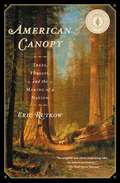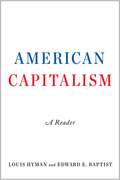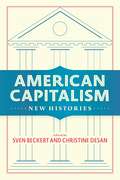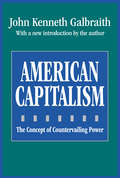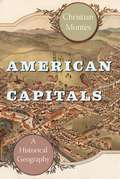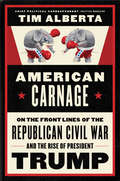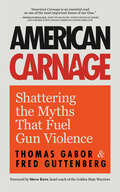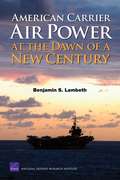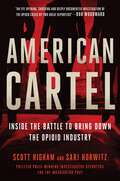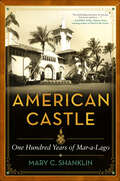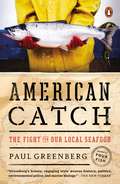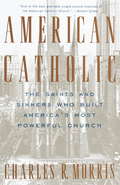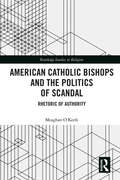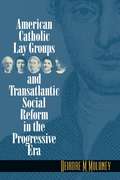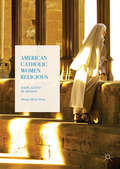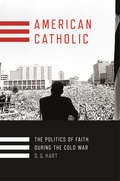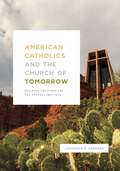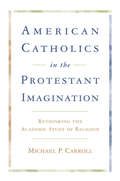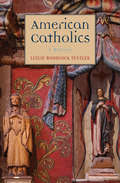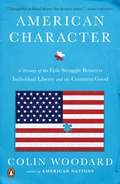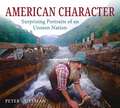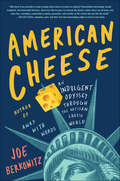- Table View
- List View
American Canopy: Trees, Forests, and the Making of a Nation
by Eric RutkowThis fascinating and groundbreaking work tells the remarkable story of the relationship between Americans and their trees across the entire span of our nation's history. Like many of us, historians have long been guilty of taking trees for granted. Yet the history of trees in America is no less remarkable than the history of the United States itself--from the majestic white pines of New England, which were coveted by the British Crown for use as masts in navy warships, to the orange groves of California, which lured settlers west. In fact, without the country's vast forests and the hundreds of tree species they contained, there would have been no ships, docks, railroads, stockyards, wagons, barrels, furniture, newspapers, rifles, or firewood. No shingled villages or whaling vessels in New England. No New York City, Miami, or Chicago. No Johnny Appleseed, Paul Bunyan, or Daniel Boone. No Allied planes in World War I, and no suburban sprawl in the middle of the twentieth century. America--if indeed it existed--would be a very different place without its millions of acres of trees. As Eric Rutkow's brilliant, epic account shows, trees were essential to the early years of the republic and indivisible from the country's rise as both an empire and a civilization. Among American Canopy's many fascinating stories: the Liberty Trees, where colonists gathered to plot rebellion against the British; Henry David Thoreau's famous retreat into the woods; the creation of New York City's Central Park; the great fire of 1871 that killed a thousand people in the lumber town of Peshtigo, Wisconsin; the fevered attempts to save the American chestnut and the American elm from extinction; and the controversy over spotted owls and the old-growth forests they inhabited. Rutkow also explains how trees were of deep interest to such figures as George Washington, Thomas Jefferson, Benjamin Franklin, Teddy Roosevelt, and FDR, who oversaw the planting of more than three billion trees nationally in his time as president. As symbols of liberty, community, and civilization, trees are perhaps the loudest silent figures in our country's history. America started as a nation of people frightened of the deep, seemingly infinite woods; we then grew to rely on our forests for progress and profit; by the end of the twentieth century we came to understand that the globe's climate is dependent on the preservation of trees. Today, few people think about where timber comes from, but most of us share a sense that to destroy trees is to destroy part of ourselves and endanger the future. Never before has anyone treated our country's trees and forests as the subject of a broad historical study, and the result is an accessible, informative, and thoroughly entertaining read. Audacious in its four-hundred-year scope, authoritative in its detail, and elegant in its execution, American Canopy is perfect for history buffs and nature lovers alike and announces Eric Rutkow as a major new author of popular history.
American Capitalism: A Reader
by Louis Hyman Edward E. Baptist"Welcome to this collection of important documents and essays about the history of American capitalism. We hope you will find these to be useful supplements to courses on the history of capitalism in the United States and elsewhere. There is no one right way to read this book, and no one right way to use it as part of a course. We only hope that you will find these readings as illuminating as we have found them. Taken together, these are the bricks and mortar that allowed us to build more than a class about a specific subject, taught in a specific format. In fact, they have enabled us to shape our understandings of how capitalism has developed and changed and how it continues to change in the United States--and how those developments and changes shape lives, here and in the rest of the world." From the forward.
American Capitalism: New Histories (Columbia Studies in the History of U.S. Capitalism)
by Edited by Sven Beckert Christine DesanThe United States has long epitomized capitalism. From its enterprising shopkeepers, wildcat banks, violent slave plantations, huge industrial working class, and raucous commodities trade to its world-spanning multinationals, its massive factories, and the centripetal power of New York in the world of finance, America has come to symbolize capitalism for two centuries and more. But an understanding of the history of American capitalism is as elusive as it is urgent. What does it mean to make capitalism a subject of historical inquiry? What is its potential across multiple disciplines, alongside different methodologies, and in a range of geographic and chronological settings? And how does a focus on capitalism change our understanding of American history?American Capitalism presents a sampling of cutting-edge research from prominent scholars. These broad-minded and rigorous essays venture new angles on finance, debt, and credit; women’s rights; slavery and political economy; the racialization of capitalism; labor beyond industrial wage workers; and the production of knowledge, including the idea of the economy, among other topics. Together, the essays suggest emerging themes in the field: a fascination with capitalism as it is made by political authority, how it is claimed and contested by participants, how it spreads across the globe, and how it can be reconceptualized without being universalized. A major statement for a wide-open field, this book demonstrates the breadth and scope of the work that the history of capitalism can provoke.
American Capitalism: The Concept of Countervailing Power
by John GalbraithIn his new introduction to this classic text on political economy, Galbraith reasserts the validity of the core thesis of American Capitalism: The best and established answer to economic power is the building of countervailing power. The trade union remains an equalizing force in the labor markets, and the chain store is the best answer to the market power of big food companies. This work remains an essential guidepost of American mores as well as that as of the American economy.
American Capitals: A Historical Geography
by Christian MontèsState capitals are an indelible part of the American psyche, spatial representations of state power and national identity. Learning them by heart is a rite of passage in grade school, a pedagogical exercise that emphasizes the importance of committing place-names to memory. But geographers have yet to analyze state capitals in any depth. In "American Capitals," Christian Mont s takes us on a well-researched journey across AmericaOCofrom Augusta to Sacramento, Albany to Baton RougeOCoshedding light along the way on the historical circumstances that led to their appointment, their success or failure, and their evolution over time. aaaaaaaaaaaWhile all state capitals have a number of characteristics in commonOCoas symbols of the state, as embodiments of political power and decision making, as public spaces with private interestsOCoMont s does not interpret them through a single lens, in large part because of the differences in their spatial and historical evolutionary patterns. Some have remained small, while others have evolved into bustling metropolises, and Mont s explores the dynamics of change and growth. All but eleven state capitals were established in the nineteenth century, thirty-five before 1861, but, rather astonishingly, only eight of the fifty states have maintained their original capitals. Despite their revered status as the most monumental and historical cities in America, capitals come from surprisingly humble beginnings, often plagued by instability, conflict, hostility, and corruption. Mont s reminds us of the period in which they came about, OC an era of pioneer and idealized territorial vision, OCO coupled with a still-evolving American citizenry and democracy. "
American Carnage: On the Front Lines of the Republican Civil War and the Rise of President Trump
by Tim AlbertaPolitico Magazine’s chief political correspondent provides a rollicking insider’s look at the making of the modern Republican Party—how a decade of cultural upheaval, populist outrage, and ideological warfare made the GOP vulnerable to a hostile takeover from the unlikeliest of insurgents: Donald J. Trump. <P><P>The 2016 election was a watershed for the United States. But, as Tim Alberta explains in American Carnage, to understand Trump’s victory is to view him not as the creator of this era of polarization and bruising partisanship, but rather as its most manifest consequence. <P><P>American Carnage is the story of a president’s rise based on a country’s evolution and a party’s collapse. As George W. Bush left office with record-low approval ratings and Barack Obama led a Democratic takeover of Washington, Republicans faced a moment of reckoning: They had no vision, no generation of new leaders, and no energy in the party’s base. Yet Obama’s forceful pursuit of his progressive agenda, coupled with the nation’s rapidly changing cultural and demographic landscape, lit a fire under the right, returning Republicans to power and inviting a bloody struggle for the party’s identity in the post-Bush era. <P><P>The factions that emerged—one led by absolutists like Jim Jordan and Ted Cruz, the other led by pragmatists like John Boehner and Mitch McConnell—engaged in a series of devastating internecine clashes and attempted coups for control. With the GOP’s internal fissures rendering it legislatively impotent, and that impotence fueling a growing resentment toward the political class and its institutions, the stage was set for an outsider to crash the party. When Trump descended a gilded escalator to announce his run in the summer of 2015, the candidate had met the moment. <P><P>Only by viewing Trump as the culmination of a decade-long civil war inside the Republican Party—and of the parallel sense of cultural, socioeconomic, and technological disruption during that period—can we appreciate how he won the White House and consider the fundamental questions at the center of America’s current turmoil. <P><P>How did a party obsessed with the national debt vote for trillion-dollar deficits and record-setting spending increases? How did the party of compassionate conservatism become the party of Muslim bans and walls? How did the party of family values elect a thrice-divorced philanderer? And, most important, how long can such a party survive? <P><P>Loaded with exclusive reporting and based off hundreds of interviews—including with key players such as President Trump, Paul Ryan, Ted Cruz, John Boehner, Mitch McConnell, Jim DeMint, and Reince Priebus, and many others—American Carnage takes us behind the scenes of this tumultuous period as we’ve never seen it before and establishes Tim Alberta as the premier chronicler of this political era. <P><b>A New York Times Bestseller</b>
American Carnage: Shattering the Myths That Fuel Gun Violence
by Thomas Gabor Fred GuttenbergShooting Down Gun Violence Misinformation"Don't tell me there's no such thing as gun violence. It happened in Parkland." ―Fred Guttenberg#1 Best Seller in School Safety, Education Policy, and Law Enforcement PoliticsFred Guttenberg, who lost his beloved daughter Jaime in the 2018 Parkland school shooting, and International gun policy consultant Thomas Gabor team up in American Carnage to dismantle some of the most common myths about guns and gun violence.A national disgrace. In America, over 40,000 die each year as a result of gun violence. Relative to other advanced countries, the U.S. has a dismal gun violence record. Gun law reforms could reduce the number of gun deaths, but many political challenges stand in the way. A widespread multi-year misinformation assault on truth by the gun lobby and gun-extremists sows doubt about the dangers of pervasive gun ownership, gun carrying, and potential effectiveness of gun laws.Debunking popular gun myths. Countering with strong evidence-based research the many slogans and myths repeated incessantly by spokespersons for the gun lobby and its surrogates is essential if we are to have a society where kids can attend school safely and people can work and enjoy life without fear of being shot. Over the last 30 years, the NRA’s campaign to achieve an armed society has succeeded in persuading many Americans that having a gun in the home or carrying a gun makes them safer. The evidence is overwhelming this is not the case. Guns in the home are far more likely to be used against a family member or in a suicide attempt than against an intruder. Tackling this and other myths is critical.Myths and slogans exposed as false in American Carnage include:Gun owners frequently use firearms to fend off attackersAn armed society is a safer societyGuns don’t kill people, people kill peopleIf you have read Trigger Points, The Violence Project, Warning Signs, or Fred Guttenberg’s Find the Helpers, American Carnage is a must read.
American Carrier Air Power at the Dawn of a New Century
by Benjamin S. LambethIn the Afghanistan war, U.S. carrier-based fighters substituted almost entirely for land-based theater air forces. The Navy's carriers again played a key role in conducting around-the-clock operations against Saddam Hussein's forces in Iraq. American carrier air power is now able to conduct coordinated deep-strike missions well beyond coastal reaches. The Navy's performance over Afghanistan and Iraq showed how the nation's carrier force can provide around-the-clock target coverage, consistently accurate target attack, and multiple successful target attacks per sortie.
American Cartel: Inside the Battle to Bring Down the Opioid Industry
by Sari Horwitz Scott HighamThe definitive investigation and exposé of how some of the nation's largest corporations created and fueled the opioid crisis—from the Pulitzer Prize-winning Washington Post reporters who first uncovered the dimensions of the deluge of pain pills that ravaged the country and the complicity of a near-omnipotent drug cartel. AMERICAN CARTEL is an unflinching and deeply documented dive into the culpability of the drug companies behind the staggering death toll of the opioid epidemic. It follows a small band of DEA agents led by Joseph Rannazzisi, a tough-talking New Yorker who had spent a storied thirty years bringing down bad guys; along with a band of lawyers, including West Virginia native Paul Farrell Jr., who fought to hold the drug industry to account in the face of the worst man-made drug epidemic in American history. It is the story of underdogs prevailing over corporate greed and political cowardice, persevering in the face of predicted failure, and how they found some semblance of justice for the families of the dead during the most complex civil litigation ever seen.The investigators and lawyers discovered hundreds of thousands of confidential corporate emails and memos during courtroom combat with legions of white-shoe law firms defending the opioid industry. One breathtaking disclosure after another—from emails that mocked addicts to invoices chronicling the rise of pill mills—showed the indifference of big business to the epidemic&’s toll. The narrative approach echoes such work as A Civil Action and The Insider, moving dramatically between corporate boardrooms, courthouses, lobbying firms, DEA field offices, and Capitol Hill while capturing the human toll of the epidemic on America&’s streets.AMERICAN CARTEL is the story of those who were on the front lines of the fight to stop the human carnage. Along the way, they suffer a string of defeats, some of their careers destroyed by the very same government officials who swore to uphold the law before they begin to prevail over some of the most powerful corporate and political influences in the nation.
American Castle: One Hundred Years of Mar-a-Lago
by Mary C. ShanklinThe characters, scandals, and secrets that shaped America's most controversial residence. Emerging from family tragedy and newfound chances, the story of Mar-a-Lago starts when heiress Marjorie Merriweather Post and investor E.F. Hutton built their ode to Roaring Twenties excess in south Florida. And as the hood ornament of Palm Beach society, not even a catastrophic hurricane could deter winter revelries there. No one could have predicted what followed: This 126-room wonder has withstood mutual adultery, high-stakes divorces, ruinous development plans, apathetic heirs, and financial collapse. All this...even before Donald Trump was given the keys to the front door. American Castle reveals a power couple's dream oasis colliding with the Kennedys, Lady Bird Johnson, Richard Nixon, the National Park Service, and Donald Trump--the man who fused a private club with a Winter White House and watched the FBI raid his own home.
American Catch
by Paul GreenbergINVESTIGATIVE REPORTERS & EDITORS Book Award, Finalist 2014 <P><P>In American Catch, award-winning author Paul Greenberg takes the same skills that won him acclaim in Four Fish to uncover the tragic unraveling of the nation's seafood supply--telling the surprising story of why Americans stopped eating from their own waters. In 2005, the United States imported five billion pounds of seafood, nearly double what we imported twenty years earlier. Bizarrely, during that same period, our seafood exports quadrupled. <P><P>American Catch examines New York oysters, Gulf shrimp, and Alaskan salmon to reveal how it came to be that 91 percent of the seafood Americans eat is foreign. In the 1920s, the average New Yorker ate six hundred local oysters a year. Today, the only edible oysters lie outside city limits. Following the trail of environmental desecration, Greenberg comes to view the New York City oyster as a reminder of what is lost when local waters are not valued as a food source. Farther south, a different catastrophe threatens another seafood-rich environment. <P><P>When Greenberg visits the Gulf of Mexico, he arrives expecting to learn of the Deepwater Horizon oil spill's lingering effects on shrimpers, but instead finds that the more immediate threat to business comes from overseas. Asian-farmed shrimp--cheap, abundant, and a perfect vehicle for the frying and sauces Americans love--have flooded the American market. Finally, Greenberg visits Bristol Bay, Alaska, home to the biggest wild sockeye salmon run left in the world. A pristine, productive fishery, Bristol Bay is now at great risk: The proposed Pebble Mine project could under¬mine the very spawning grounds that make this great run possible. In his search to discover why this precious renewable resource isn't better protected, Green¬berg encounters a shocking truth: the great majority of Alaskan salmon is sent out of the country, much of it to Asia. Sockeye salmon is one of the most nutritionally dense animal proteins on the planet, yet Americans are shipping it abroad. <P><P>Despite the challenges, hope abounds. In New York, Greenberg connects an oyster restoration project with a vision for how the bivalves might save the city from rising tides. In the Gulf, shrimpers band together to offer local catch direct to consumers. And in Bristol Bay, fishermen, environmentalists, and local Alaskans gather to roadblock Pebble Mine. With American Catch, Paul Greenberg proposes a way to break the current destructive patterns of consumption and return American catch back to American eaters.
American Catholic
by Charles Morris"A cracking good story with a wonderful cast of rogues, ruffians and some remarkably holy and sensible people." --Los Angeles Times Book ReviewBefore the potato famine ravaged Ireland in the 1840s, the Roman Catholic Church was barely a thread in the American cloth. Twenty years later, New York City was home to more Irish Catholics than Dublin. Today, the United States boasts some sixty million members of the Catholic Church, which has become one of this country's most influential cultural forces.In American Catholic: The Saints and Sinners Who Built America's Most Powerful Church, Charles R. Morris recounts the rich story of the rise of the Catholic Church in America, bringing to life the personalities that transformed an urban Irish subculture into a dominant presence nationwide. Here are the stories of rogues and ruffians, heroes and martyrs--from Dorothy Day, a convert from Greenwich Village Marxism who opened shelters for thousands, to Cardinal William O'Connell, who ran the Church in Boston from a Renaissance palazzo, complete with golf course. Morris also reveals the Church's continuing struggle to come to terms with secular, pluralist America and the theological, sexual, authority, and gender issues that keep tearing it apart. As comprehensive as it is provocative, American Catholic is a tour de force, a fascinating cultural history that will engage and inform both Catholics and non-Catholics alike."The best one-volume history of the last hundred years of American Catholicism that it has ever been my pleasure to read. What's appealing in this remarkable book is its delicate sense of balance and its soundly grounded judgments." --Andrew GreeleyFrom the Trade Paperback edition.
American Catholic Bishops and the Politics of Scandal: Rhetoric of Authority (Routledge Studies in Religion)
by Meaghan O'KeefeThis book explores the rhetoric and public communication of the Catholic Church in the United States in the wake of the sexual abuse scandals and offers a demonstration of how large organizations negotiate a loss of public trust while retaining political power. While the Catholic Church remains a major political force in the United States, recent scandals have undoubtedly had an adverse effect on both its reputation and moral authority. This has been exacerbated by the public responses of Catholic clergy, which have often left supporters of the Church, let alone critics, profoundly unsatisfied. Drawing on documents – voting guides, pastoral letters, sermons, press releases, and other materials – issued by the United States Conference of Catholic Bishops (USCCB) as well as American nuns, the book explores Catholic political statements issued after the sexual abuse crises entered the public consciousness. Using approaches from linguistics and rhetoric, it analyses how these statements compare to similar materials issued before this time. This comparison demonstrates that for the American Catholic Church persuasion is less important than maintaining the impression that there has been no loss of authority. This is a timely study of the Catholic Church’s handling of the recent revelations of abuse within the Church. As such, it will be of keen interest to scholars of religious rhetoric, contemporary Catholicism, linguistics, rhetoric, communication, and religious studies.
American Catholic Lay Groups and Transatlantic Social Reform in the Progressive Era
by Deirdre M. MoloneyTracing the development of social reform movements among American Catholics from 1880 to 1925, Deirdre Moloney reveals how Catholic gender ideologies, emerging middle-class values, and ethnic identities shaped the goals and activities of lay activists. Rather than simply appropriate American reform models, ethnic Catholics (particularly Irish and German Catholics) drew extensively on European traditions as they worked to establish settlement houses, promote temperance, and aid immigrants and the poor. Catholics also differed significantly from their Protestant counterparts in defining which reform efforts were appropriate for women. For example, while women played a major role in the Protestant temperance movement beginning in the mid-nineteenth century, Catholic temperance remained primarily a male movement in America. Gradually, however, women began to carve out a significant role in Catholic charitable and reform efforts. <P>The first work to highlight the wide-ranging contributions of the Catholic laity to Progressive-era reform, the book shows how lay groups competed with Protestant reformers and at times even challenged members of the Catholic hierarchy. It also explores the tension that existed between the desire to demonstrate the compatibility of Catholicism with American values and the wish to preserve the distinctiveness of Catholic life.
American Catholic Women Religious: Radicalized by Mission
by Donna Maria MosesThis book depicts the significant role played by American Catholic Women Religious in the broader narratives of modern American history and the history of the Catholic Church. The book is a guide to fifty foreign missions founded by Dominican and Maryknoll Sisters in the twentieth century. Sister Donna Moses examines root causes for the radical political stances taken by American Catholic Women Religious in the latter half of the century and for the conservative backlash that followed. The book identifies key events that contributed to the present state of division within the American Catholic Church and describes current efforts to engage in dynamic dialogue.
American Catholic: The Politics of Faith During the Cold War (Religion and American Public Life)
by D. G. HartAmerican Catholic places the rise of the United States' political conservatism in the context of ferment within the Roman Catholic Church. How did Roman Catholics shift from being perceived as un-American to emerging as the most vocal defenders of the United States as the standard bearer in world history for political liberty and economic prosperity? D. G. Hart charts the development of the complex relationship between Roman Catholicism and American conservatism, and shows how these two seemingly antagonistic ideological groups became intertwined in advancing a certain brand of domestic and international politics. Contrary to the standard narrative, Roman Catholics were some of the most assertive political conservatives directly after World War II, and their brand of politics became one of the most influential means by which Roman Catholicism came to terms with American secular society. It did so precisely as bishops determined the church needed to update its teaching about its place in the modern world. Catholics grappled with political conservatism long before the supposed rightward turn at the time of the Roe v. Wade decision in 1973.Hart follows the course of political conservatism from John F. Kennedy, the first and only Roman Catholic president of the United States, to George W. Bush, and describes the evolution of the church and its influence on American politics. By tracing the roots of Roman Catholic politicism in American culture, Hart argues that Roman Catholicism's adaptation to the modern world, whether in the United States or worldwide, was as remarkable as its achievement remains uncertain. In the case of Roman Catholicism, the effects of religion on American politics and political conservatism are indisputable.
American Catholics and the Church of Tomorrow: Building Churches for the Future, 1925–1975
by Catherine R. OsborneIn the mid-twentieth century, American Catholic churches began to shed the ubiquitous spires, stained glass, and gargoyles of their European forebears, turning instead toward startling and more angular structures of steel, plate glass, and concrete. But how did an institution like the Catholic Church, so often seen as steeped in inflexible traditions, come to welcome this modernist trend? Catherine R. Osborne’s innovative new book finds the answer: the alignment between postwar advancements in technology and design and evolutionary thought within the burgeoning American Catholic community. A new, visibly contemporary approach to design, church leaders thought, could lead to the rebirth of the church community of the future. As Osborne explains, the engineering breakthroughs that made modernist churches feasible themselves raised questions that were, for many Catholics, fundamentally theological. Couldn’t technological improvements engender worship spaces that better reflected God's presence in the contemporary world? Detailing the social, architectural, and theological movements that made modern churches possible, American Catholics and the Churches of Tomorrow breaks important new ground in the history of American Catholicism, and also presents new lines of thought for scholars attracted to modern architectural and urban history.
American Catholics and the Quest for Equality in the Civil War Era
by Robert Emmett CurranRobert Emmett Curran’s masterful treatment of American Catholicism in the Civil War era is the first comprehensive history of Roman Catholics in the North and South before, during, and after the war. Curran provides an in-depth look at how the momentous developments of these decades affected the entire Catholic community, including Black and indigenous Americans. He also explores the ways that Catholics contributed to the reshaping of a nation that was testing the fundamental proposition of equality set down by its founders. Ultimately, Curran concludes, the revolution that the war touched off remained unfinished, indeed was turned backward, in no small part by Catholics who marred their pursuit of equality with a truncated vision of who deserved to share in its realization.
American Catholics in the Protestant Imagination: Rethinking the Academic Study of Religion
by Michael P. CarrollMichael P. Carroll argues that the academic study of religion in the United States continues to be shaped by a "Protestant imagination" that has warped our perception of the American religious experience and its written history and analysis.In this provocative study, Carroll explores a number of historiographical puzzles that emerge from the American Catholic story as it has been understood through the Protestant tradition. Reexamining the experience of Catholicism among Irish immigrants, Italian Americans, Acadians and Cajuns, and Hispanics, Carroll debunks the myths that have informed much of this history.Shedding new light on lived religion in America, Carroll moves an entire academic field in new, exciting directions and challenges his fellow scholars to open their minds and eyes to develop fresh interpretations of American religious history.
American Catholics: A History (Cushwa Center Studies Of Catholicism In Twentieth-century America)
by Leslie Woodcock TentlerA sweeping history of American Catholicism from the arrival of the first Spanish missionaries to the present This comprehensive survey of Catholic history in what became the United States spans nearly five hundred years, from the arrival of the first Spanish missionaries to the present. Distinguished historian Leslie Tentler explores lay religious practice and the impact of clergy on Catholic life and culture as she seeks to answer the question, What did it mean to be a "good Catholic" at particular times and in particular places? In its focus on Catholics' participation in American politics and Catholic intellectual life, this book includes in-depth discussions of Catholics, race, and the Civil War; Catholics and public life in the twentieth century; and Catholic education and intellectual life. Shedding light on topics of recent interest such as the role of Catholic women in parish and community life, Catholic reproductive ethics regarding birth control, and the Catholic church sex abuse crisis, this engaging history provides an up-to-date account of the history of American Catholicism.
American Character: A History of the Epic Struggle Between Individual Liberty and the Common Good
by Colin WoodardThe author of American Nations examines the history of and solutions to the key American question: how best to reconcile individual liberty with the maintenance of a free society The struggle between individual rights and the good of the community as a whole has been the basis of nearly every major disagreement in our history, from the debates at the Constitutional Convention and in the run up to the Civil War to the fights surrounding the agendas of the Federalists, the Progressives, the New Dealers, the civil rights movement, and the Tea Party. In American Character, Colin Woodard traces these two key strands in American politics through the four centuries of the nation’s existence, from the first colonies through the Gilded Age, Great Depression and the present day, and he explores how different regions of the country have successfully or disastrously accommodated them. The independent streak found its most pernicious form in the antebellum South but was balanced in the Gilded Age by communitarian reform efforts; the New Deal was an example of a successful coalition between communitarian-minded Eastern elites and Southerners. Woodard argues that maintaining a liberal democracy, a society where mass human freedom is possible, requires finding a balance between protecting individual liberty and nurturing a free society. Going to either libertarian or collectivist extremes results in tyranny. But where does the “sweet spot” lie in the United States, a federation of disparate regional cultures that have always strongly disagreed on these issues? Woodard leads readers on a riveting and revealing journey through four centuries of struggle, experimentation, successes and failures to provide an answer. His historically informed and pragmatic suggestions on how to achieve this balance and break the nation’s political deadlock will be of interest to anyone who cares about the current American predicament—political, ideological, and sociological.From the Hardcover edition.
American Character: Surprising Portraits of an Unseen Nation
by Peter GuttmanAward-winning photographer Peter Guttman showcases the vibrant and wildly diverse American people in an unprecedented, multi-decade collection of sharply etched portraits Like few nations, the United States flourished through the hard work and enterprising creativity of individuals from myriad identities. These cultural strands––along with sprinklings of imagination, eccentricity, even skullduggery––weave together an entertaining narrative of a fascinating country. American Character offers readers a peek into the seldom viewed worlds of Buddhist monks, "freak show" performers, and nuclear physicists, and an opportunity to tag along on the quests of gold miners and Bigfoot hunters. Diving into the ethnic enclaves of Yupik hunters, Amish farmers, Hopi elders, native Hawaiian storytellers, and Hasidic bakery owners, the book also trains a lens on distant or underseen communities to cobble together an unforgettable American landscape. Driven by an explorer&’s fearless instinct for investigating obscure cultures and hidden corners in all fifty states, photographer and journalist Peter Guttman presents this richly visual parade in stunning color photography, accompanied with evocative, deeply researched prose. Almost encyclopedic in scope, a dizzying array of arresting occupational niches and lifestyles are presented and enhanced with intriguing personal backstories, winding connections, and amusing historical tales. When each half of a polarized country seems to view the other half with deep suspicions, American Character may provide a healing balm and offer much deeper understanding of the vast spectrum of Americans and our mutual aspirations.
American Character: The Curious Life of Charles Fletcher Lummis and the Rediscovery of the Southwest
by Mark ThompsonCharles Fletcher Lummis began his spectacular career in 1884 by walking from Ohio to start a new job at the three-year old Los Angeles Times. By the time of his death in 1928, the 3,500 mile "tramp across the continent" was just a footnote in his astonishingly varied career: crusading journalist, author of nearly two dozen books, editor of the influential political and literary magazine Out West, Los Angeles city librarian, preserver of Spanish missions, and Indian rights gadfly. Lummis both embodied and defined our vision of the West, and of America itself.
American Cheese: An Indulgent Odyssey Through the Artisan Cheese World
by Joe BerkowitzFrom the author of Away with Words, a deeply hilarious and unexpectedly insightful deep-dive into a cultural and culinary phenomenon: cheese.“Who knew it was possible to enjoy reading about cheese as much as eating it? Remarkably entertaining, deeply insightful, and downright hilarious, American Cheese goes far beyond the plastic yellow slices we all know, and some love, revealing a community as quirky, passionate, and creative as the cheese they put into the world.” — Jim Gaffigan, comedian/actor and New York Times bestselling author of Food: A Love StoryJoe Berkowitz loves cheese. Or at least he thought he did. After stumbling upon an artisinal tasting at an upscale cheese shop one Valentine’s Day, he realized he’d hardly even scratched the surface. These cheeses were like nothing he had ever tasted—a visceral drug-punch that reverberated deliciousness—and they were from America. He felt like he was being let in a great cosmic secret, and instantly he was in love.This discovery inspired Joe to embark on the cheese adventure of a lifetime, spending a year exploring the subculture around cheese, from its trenches to its command centers. He dove headfirst into the world of artisan cheese; of premiere makers and mongers, cave-dwelling affineurs, dairy scientists, and restauranteurs. The journey would take him around the world, from the underground cheese caves in Paris to the mountains of Gruyere, leaving no curd unturned, all the while cultivating an appreciation for cheese and its place in society.Joe’s journey from amateur to aficionado eventually comes to mirror the rise of American cheese on the world stage. As he embeds with Team USA at an international mongering competition and makes cheese in the experimental vats at the Dairy Research Center in Wisconsin, one of the makers he meets along the way gears up to make America’s biggest splash ever at the World Cheese Awards. Through this odyssey of cheese, an unexpected culture of passionate cheesemakers is revealed, along with the extraordinary impact of one delicious dairy product.
American Chemical Corp.
by William E. Fruhan John P. GoldsberryA large chemical manufacturer divests a plant that is acquired by a small specialty chemicals manufacturer. The acquisition decision is viewed from the vantage point of the small specialty chemicals manufacturer.
